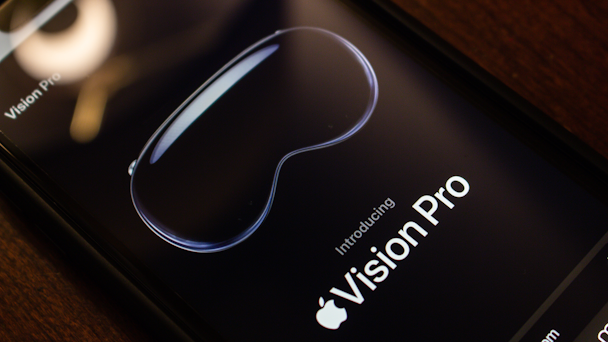Should brands be preparing for the rise of the Apple Vision Pro?
Yes, it’s prohibitively expensive for the average person, and no, it might not have the most aesthetically pleasing design imaginable. But some experts argue that Apple’s new headset is just the first step in a new wave of technology that’s going to transform the world.

The Apple Vision Pro is slated for release in early 2024. / Adobe Stock
Earlier this month, Apple finally unveiled its much-anticipated Vision Pro headset. The internet's reaction to the device – which is slated for release early next year – has been a mixed bag. Many on Twitter were quick to roundly mock the headset’s price tag (a whopping $3,499), while others giggled at its ski goggle-esque appearance.
should i buy a used car or an apple vision pro
— rat king (@MikeIsaac) June 5, 2023
imagine paying $3500 plus tax to look like this when someone walks in the room to have a serious conversation with you pic.twitter.com/eFclrVY74X — Casey Johnston (@caseyjohnston) June 5, 2023
Such derision is par for the course for companies attempting to break into the burgeoning world of high-tech headsets. Meta, for example, has spent huge amounts of time and money trying to make its latest virtual reality (VR) headset, the Quest Pro 2 – as well as its VR platform, Horizon Worlds – look intuitive and appealing. But sales of the Quest Pro 2 have been modest, Horizon Worlds’ usership is low and Meta as a company has begun to pivot away from VR and towards artificial intelligence (AI), the new apple of seemingly every major tech company’s eye.
It’s not that surprising, in other words, that much of the internet has been ridiculing the Apple Vision Pro. But not everyone is laughing. Cathy Hackl – a futurist and an author who has been dubbed “godmother of the metaverse” – seems to consider Apple’s latest piece of hardware a kind of technological holy grail, an innovation that eclipses all those before it and that‘s likely to usher in a new era of entertainment, communication and yes, marketing.
The Apple Vision Pro “is the most advanced tech product ever created,” Hackl told The Drum in an email shortly after the device was revealed to the world. Later, in an interview, she raved over the headset’s gesture recognition feature (rather than being paired with handheld remote controls, à la the Quest Pro 2, the display in Apple’s headset can be navigated by the user’s empty hands): “That is magic,” she said.
Hackl – who during her career has assumed various roles with VR industry leaders like HTC Vive, Oculus and Magic Leap – adds that her extensive experience working in this space has given her some unique insight into the scope of technical challenges that had to be overcome in order for Apple to build its new headset. “I know … how hard [it] actually is to put a supercomputer on someone‘s face.”
Advertisement
A new kind of experience
According to Hackl, the introduction of the Apple Vision Pro is a signal of things to come – and brands would do well to pay attention.
While mainstream culture has grown accustomed to 2D digital experiences since the introduction of the first iPhone in 2007, Hackl believes that we could soon collectively witness the rise of 3D, “spatial” experiences; that is, digital experiences in which we can deeply immerse ourselves. Rather than interfacing with a flat screen, spatial experiences would enable us to simply reach out into the surrounding space and engage with virtual elements.
“Preparing for that shift in 3D and spacial thinking is something that I think a lot of brands are going to have to think about,” she says.
The immersive digital experience has, of course, been a cornerstone of the marketing strategy that Meta has deployed to sell the culture on its version of the ’metaverse.’ Many have seen videos of Meta founder and CEO Mark Zuckerberg extolling the virtual future of humanity, a future in which he believes (or at least at one point believed) most of us will work, play and socialize as virtual avatars.
But Apple isn’t selling the avatar-oriented virtual experience; instead, the company is positioning its new headset as a device that can enable the user to more dynamically engage with the physical world, through AR, while also immersing themselves in completely virtual spaces – while watching a movie, say – should they choose to do so. (The Vision Pro comes with a small toggle wheel that transitions the user’s experience between AR and VR.)
Advertisement
Hackl also argues that the advent of the Apple Vision Pro could usher in a new wave of marketing efforts that are more oriented around the experiences of individual users, as opposed to those which are geared towards providing essentially the same experience to a large number of people. There can only ever be one person behind the headset, after all, which means it will be important for brands to bear in mind how their own customer-facing AR/VR experiences are being experienced subjectively.
“One of the metrics that brands are eventually going to have to think about is quality of experience,” she says. “That's not something that we [traditionally] think about. The metrics tend to always be: how many people visited, how many clicks and how long did they stay? But it’s going to start to be a little bit more subjective: what is the quality of the experience that you’re giving people?”
Suggested newsletters for you
A technology still in its infancy
Despite her enthusiasm about the Apple Vision Pro, Hackl believes that its price and its currently limited content offerings make it a niche device that isn’t likely to enjoy mainstream appeal – not yet, at least. “It’s not for everyone,” she says. “But in a couple of years, it’s going to be a device that everyone wants to have.”
Jen Jones, chief marketing officer at e-commerce platform Commercetools, echoes this idea that Apple’s new headset could soon become a cultural mainstay. ”The real barrier,” she says, “is going to be: When are there apps that make you want to [buy the device]?”
She envisions a “snowball effect” in which app developers notice enough people using the headset that they decide to build new apps, which in turn draws in more users, leading to more apps, and so on. She compares this potential phenomenon with that which propelled the iPhone into mainstream appeal, which she believes was driven largely by the rise popular apps. “It was really the launch of the App Store that changed everything,” she says.
If a successor to the Apple Vision Pro eventually becomes a ubiquitous device – an outcome which Jones “absolutely” believes in – she says that “it’s going to fundamentally change the way we operate with our environment with each other, just like mobile phones did.”
Jones says that it’s anyone’s guess as to when that successor might arrive, but that when it does, brands are going to want to be ready to embrace and capitalize upon the cultural shift that it’s going to precipitate. “The smart brands and retailers need to have a plan,” she says. “Because who knows, maybe the next iteration [of the Apple Vision Pro] is going to be amazing, and it's going to cost $500, and they’re going to announce all of these new apps. You just don’t know – maybe it’s five years out, but it’s coming."
For more on the latest happenings in AI, web3 and other cutting-edge technologies, sign up for The Emerging Tech Briefing newsletter.

